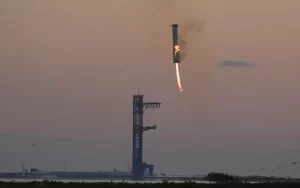
By Sean McClinton
On October 12, 2024, SpaceX achieved a significant milestone with the successful test of its Starship system, where the booster was expertly caught by the launch tower—a feat that underscored the increasing odds of success for future Starship missions. This event not only showcased SpaceX’s engineering prowess but also highlighted the growing importance of robust ground station communications in the age of next-gen spacecraft.
As the SpaceX team celebrates this achievement, we at RBC Signals are looking ahead to the implications of Starship’s success, particularly in terms of satellite communications and ground station infrastructure. Here’s why we believe the advancements brought by Starship will fundamentally reshape our approach to ground station operations.
Improving Odds of Increasing Spacecraft
The recent successful test is a strong indication that SpaceX is on a trajectory toward making the Starship system operational. With each test flight, the engineering team gathers crucial data and refines their processes, which ultimately boosts the overall odds of mission success. Falcon 9 can carry 15,600 kg to LEO when in a reusable configuration. Starship is capable of carrying 150 tons (970kg to 1 ton) to LEO in a reusable configuration. As Starship transitions from testing to operational flights, it opens the door to a new era of space missions, including an increase in the frequency and scale of satellite deployments.
The Challenge of Multiple Deployments
One of the most significant challenges posed by Starship’s larger payload capacity is the simultaneous deployment of multiple satellites. When many spacecraft are released at once, tracking them with traditional ground stations immediately becomes complex. This complexity is exacerbated by the fact that Starship can carry a more extensive array of payloads, making each mission potentially more dynamic.
To address this challenge, RBC Signals offers an innovative solution through our Go.BIC service. This service allows spacecraft operators to send a signal from low Earth orbit (LEO) to a satellite in geostationary orbit (GEO). By leveraging this capability, operators can quickly locate and communicate with their satellites after launch, facilitating faster data acquisition and operational readiness. In a landscape where time is of the essence, such tools will be invaluable.
Handling Increased Data Rate Demands
Starship’s ability to carry larger and more capable spacecraft also means that the amount of data generated will increase significantly. As these spacecrafts take on more advanced missions—whether for Earth observation, telecommunications, or deep space exploration—the demand for higher data rates will escalate. This shift will necessitate the use of higher frequencies, such as Ka-band and optical communications, which can support the transmission of larger data volumes.
At RBC Signals, we are prepared to meet this demand by expanding our ground station capabilities at higher frequencies. We recently deployed a new tri-band (S/X/Ka) antenna in Deadhorse, Alaska to support SSO satellites in LEO at higher data rates in Ka-band. We are continually enhancing our infrastructure to support the evolving needs of our clients, ensuring that as satellite technology advances, communication capabilities keep pace.
Cislunar Missions and Strategic Ground Stations
Looking further ahead, Starship’s design is not just limited to Earth orbit. It is capable of supporting cislunar missions—operations that occur in the space between the Earth and the Moon. These missions will require more significant antenna systems strategically located in mid-latitude or equatorial regions. The placement of ground stations will be critical in providing seamless communication with spacecraft traveling to and from the Moon, as well as those undertaking deeper space missions.
At RBC Signals, we are keenly aware of the importance of geographical positioning for ground stations. Our extensive network of global ground stations is designed to adapt to the evolving landscape of space exploration, including the needs of cislunar operations.
Conclusion
The successful October test of SpaceX’s Starship has set the stage for a transformative era in space exploration. As we move toward more ambitious missions, the need for reliable and advanced ground station communications has never been more critical. At RBC Signals, we are committed to enhancing our services to ensure that operators have the tools they need to navigate the complexities of tracking and communicating with their spacecraft effectively. As the cosmos continues to open up, we stand ready to support the pioneers of the new space age.
